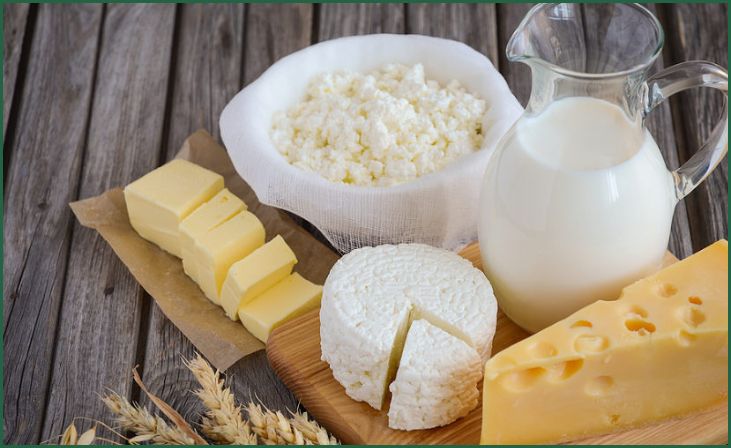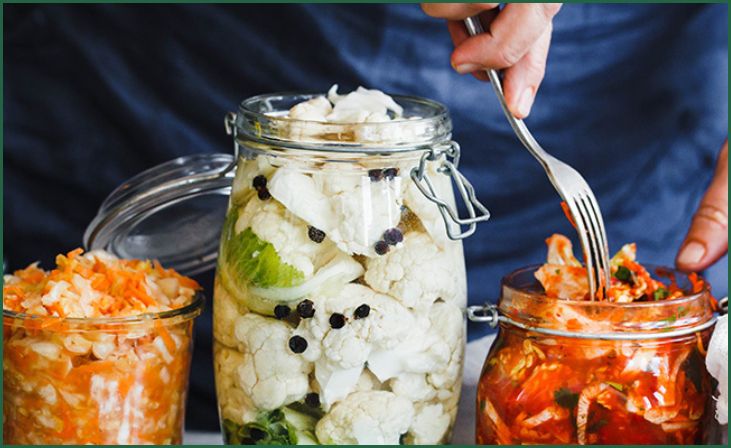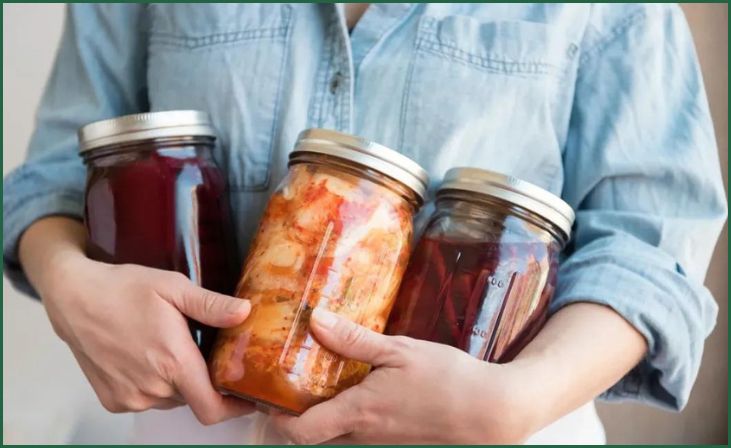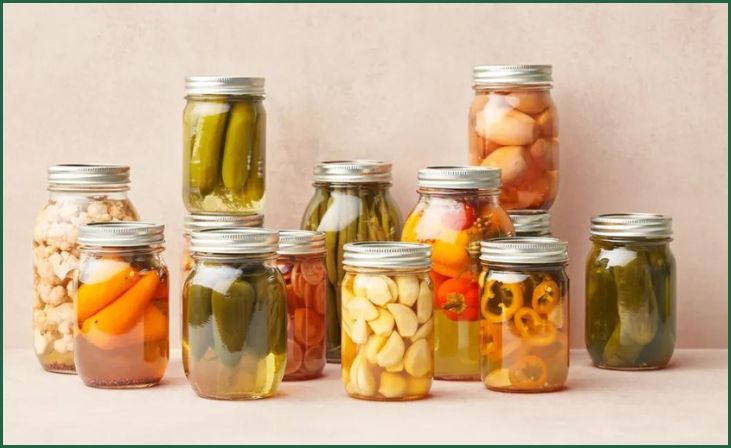Lactose Intolerance And Lacto Fermentation are two fascinating aspects of our dietary world, influencing our digestive well-being and culinary experiences. In this guide, we delve deep into the intricacies of Lactose Intolerance, exploring its causes, symptoms, and practical management strategies. Additionally, we unravel the mysteries of Lacto Fermentation, shedding light on the health benefits and risks associated with fermented foods.
Table of Contents
ToggleUnderstanding Lactose Intolerance: A Genetic and Health Odyssey

Genetic Factors: Unraveling the Genetic Code
In the intricate realm of Lactose Intolerance, genetic factors emerge as silent orchestrators, playing a pivotal role in shaping individual predispositions. Delving into the genetic code opens a window into the personalized landscape of lactose tolerance.
Also Read:- Veggies Under The Brine
Deciphering the Genetic Blueprint
Understanding your genetic makeup is akin to deciphering a unique code that governs how your body processes lactose. Genetic variations influence the production of lactase, the enzyme responsible for breaking down lactose. This section serves as a compass, guiding you through the labyrinth of genetic intricacies that either confer lactose tolerance or set the stage for intolerance.
Personalized Insights
By gaining insights into your genetic predisposition, you’re empowered with a nuanced understanding of your relationship with lactose. This knowledge not only demystifies your current tolerance status but also sheds light on potential trajectories, offering a glimpse into the future of your lactose metabolism.
Secondary Lactose Intolerance: Unmasking Underlying Causes
Beyond the genetic script, the narrative of lactose intolerance takes a nuanced turn with the emergence of secondary lactose intolerance. Unlike its genetic counterpart, secondary lactose intolerance is a consequence of underlying health conditions.
Health as a Contributing Factor
Unmasking underlying causes involves a comprehensive exploration of health conditions that can compromise lactose digestion. Chronic illnesses, gastrointestinal disorders, or injuries to the small intestine can disrupt the normal functioning of lactase, leading to secondary lactose intolerance.
Medications and Treatments
Certain medications and treatments may also contribute to the development of secondary lactose intolerance. Chemotherapy, for instance, can damage the cells lining the small intestine, affecting lactase production. Understanding the medication-induced facets of lactose intolerance is crucial for individuals navigating these treatment landscapes.
Temporary Nature
One defining characteristic of secondary lactose intolerance is its potential reversibility. Addressing the underlying health issues or modifying medication regimens can, in some cases, restore lactose tolerance. This aspect adds a layer of optimism, emphasizing that the journey with secondary lactose intolerance is often intertwined with the management and resolution of the associated health conditions.
Navigating the Intersection
A Holistic Approach
Understanding both genetic and secondary factors allows for a holistic approach to managing lactose intolerance. The combination of genetic predispositions and health dynamics creates a unique roadmap for individuals, guiding them towards tailored strategies for optimal lactose digestion.
Personalized Dietary Choices
Armed with knowledge about genetic predispositions and potential health triggers, individuals can make informed dietary choices. Tailoring the intake of lactose-containing foods based on individual tolerance levels becomes an empowering aspect of managing lactose intolerance effectively.
Symptoms of Lactose Intolerance: Unveiling the Digestive Drama

Digestive Discomfort: Navigating the Unease
Lactose intolerance, often characterized by a digestive drama, unravels itself through a spectrum of discomfort. Navigating this unease requires a nuanced understanding of the diverse ways in which lactose intolerance manifests itself.
Unveiling the Digestive Symphony
The hallmark of lactose intolerance is digestive discomfort, a symphony of symptoms that may include bloating, abdominal pain, gas, and diarrhea. This section delves into each note of this digestive symphony, offering insights into the intricate nuances of discomfort.
Varied Manifestations
Symptoms may vary from person to person, creating a unique tapestry of discomfort. While some individuals may experience mild bloating, others might grapple with more pronounced abdominal pain. By navigating the varied manifestations, individuals can better recognize and manage the specific challenges posed by their lactose intolerance.
Impact on Daily Life: Embracing Lifestyle Modifications
Beyond the confines of digestive discomfort, lactose intolerance ripples into daily life, necessitating a dance of adaptations and modifications.
Crafting a Lactose-Aware Lifestyle
Living with lactose intolerance entails a shift in dietary paradigms. Discovering the art of crafting a lactose-aware lifestyle involves understanding the lactose content of various foods, deciphering food labels, and making informed choices that align with individual tolerance levels.
Social and Culinary Adaptations
The impact extends beyond personal dietary choices, influencing social interactions and culinary experiences. Managing lactose intolerance seamlessly involves navigating social gatherings, communicating dietary needs, and exploring culinary alternatives that cater to both taste buds and digestive comfort.
Practical Tips and Tricks
This section provides a treasure trove of practical tips and tricks for individuals looking to manage lactose intolerance with finesse. From decoding ingredient lists to experimenting with lactose-free recipes, these insights empower individuals to embrace lifestyle modifications without sacrificing culinary enjoyment.
On-the-Go Strategies
Living with lactose intolerance doesn’t mean compromising on spontaneity. Discover strategies for managing lactose intolerance on the go, ensuring that individuals can navigate various dining scenarios with confidence and ease.
Diagnosis and Testing: Illuminating the Path to Certainty

Lactose Tolerance Test: Decoding Diagnostic Measures
In the quest for certainty regarding lactose intolerance, diagnostic measures take center stage, with the lactose tolerance test being a key player. This diagnostic tool serves as a beacon, guiding individuals towards a clearer understanding of their lactose metabolism.
The Testing Ritual
The lactose tolerance test involves a systematic process to assess how the body processes lactose. This section navigates through the testing ritual, explaining the step-by-step procedures, from fasting prior to the test to the consumption of a lactose-containing beverage. Understanding the nuances of this diagnostic journey empowers individuals with knowledge about what to expect during the testing procedure.
Interpreting Results
Beyond undergoing the lactose tolerance test, interpreting the results is crucial for unraveling the mystery of lactose intolerance. This segment delves into the various outcomes, from normal lactose tolerance to incomplete or absent lactase activity. Deciphering these results lays the foundation for informed decisions regarding dietary choices and lifestyle adaptations.
Hydrogen Breath Test: Unveiling Hidden Clues
A complementary diagnostic tool in the realm of lactose intolerance is the hydrogen breath test, providing a unique lens to unveil hidden clues about lactose absorption.
Breath by Breath Analysis
This test involves measuring the levels of hydrogen in the breath, offering insights into the fermentation of undigested lactose in the colon. By unraveling the intricacies of this diagnostic procedure, individuals gain a deeper understanding of how their body responds to lactose consumption.
The Significance of Elevated Hydrogen Levels
Elevated hydrogen levels detected during the hydrogen breath test signify incomplete lactose digestion, providing valuable information about the efficiency of lactase enzyme activity. This section explores the significance of these findings, empowering individuals to comprehend the implications of their hydrogen breath test results.
Also Read:- How to Make Whole Brined Pears Easily
Genetic Testing: Know Your Genetic Blueprint
In the era of personalized medicine, genetic testing emerges as a powerful tool for understanding lactose intolerance at its roots.
Unraveling the Genetic Blueprint
Genetic testing offers a unique lens to unravel the individual’s genetic blueprint related to lactose intolerance. This section explores the process of genetic testing, from sample collection to result interpretation. Understanding one’s genetic predisposition to lactose intolerance enhances the depth of knowledge about this condition.
Personalized Risk Assessment
The role of genetic testing extends beyond diagnosis, providing a personalized risk assessment for lactose intolerance. By deciphering the genetic code, individuals gain insights into their inherent susceptibility, paving the way for proactive management strategies tailored to their unique genetic makeup.
Managing Lactose Intolerance: Nurturing Dietary Harmony

Dietary Modifications: Crafting a Lactose-Free Menu
Crafting a delectable and satisfying lactose-free menu is an art that empowers individuals with lactose intolerance to savor a world of culinary delights. This section is a culinary journey, exploring alternative dairy options and inspiring creative recipes that transcend the limitations of lactose.
Don't just scroll, subscribe!
BuzzTrail's unique web-stories are the cure for boredom you've been waiting for.
Exploring Alternative Dairy Options
Navigating the world of lactose-free living involves discovering a palette of alternative dairy options. From almond milk to oat milk, this section serves as a guide to diverse milk alternatives, helping individuals make informed choices that align with their taste preferences and nutritional needs.
Creative Recipes for Delightful Dining
Dive into the realm of creative recipes that transcend traditional dairy-centric cuisines. From lactose-free desserts to savory delights, this section presents a treasure trove of culinary inspiration, ensuring that individuals with lactose intolerance can indulge in a rich and varied menu without compromise.
Lactase Supplements: Enzymatic Support
Lactase supplements emerge as a transformative ally for individuals seeking to navigate lactose intolerance seamlessly. This section unveils the mechanics behind these supplements and offers guidance on their effective incorporation into daily routines.
Decoding the Magic of Lactase
Lactase supplements contain the enzyme lactase, which aids in the digestion of lactose. This segment delves into the science behind lactase supplements, explaining how they work to break down lactose into more digestible forms, alleviating digestive discomfort.
Incorporating Lactase into Your Routine
Learn practical strategies for incorporating lactase supplements into daily life. From timing considerations to dosage guidelines, this section provides insights into optimizing the efficacy of lactase supplements, ensuring individuals can enjoy lactose-containing foods with confidence.
Probiotics and Fermented Foods: Cultivating Gut Health
Cultivating a thriving gut microbiota is a cornerstone of managing lactose intolerance, and probiotics and fermented foods stand as potent contributors to this endeavor.
The Role of Probiotics in Gut Health
Explore the benefits of probiotics, the beneficial bacteria that promote a balanced and healthy gut microbiota. From improving digestion to enhancing immune function, this section unravels the myriad ways in which probiotics contribute to overall well-being.
Diverse Options for Gut-Friendly Delights
Embark on a culinary journey with an array of fermented foods that contribute to gut health. From yogurt to kimchi, discover diverse options for incorporating these gut-friendly delights into your daily diet. This section serves as a guide to both store-bought and homemade fermented foods, providing flexibility and variety.
Integrating Probiotics into Your Diet
Practical tips for seamlessly integrating probiotics and fermented foods into daily life are unveiled here. From choosing the right probiotic supplements to incorporating fermented delights into meals, this section empowers individuals to make intentional choices that foster a flourishing gut environment.
Lacto Fermentation Explained: A Symphony of Beneficial Bacteria

Beneficial Bacteria: Harnessing the Power of Probiotics
At the heart of lacto fermentation lies the captivating dance of beneficial bacteria, ushering in a realm of probiotic wonders. This section delves into the intricate science behind the fermentation process and the profound impact it has on nurturing a harmonious gut environment.
The Symphony of Lactic Acid Bacteria
Lacto fermentation is orchestrated by lactic acid bacteria, the unsung heroes that transform raw ingredients into culinary delights. Uncover the scientific nuances of this bacterial symphony, exploring how lactic acid bacteria thrive in the absence of oxygen, converting sugars into lactic acid and creating an environment hostile to harmful pathogens.
The Probiotic Powerhouse
Discover the inherent probiotic power within lacto-fermented foods. As beneficial bacteria multiply during fermentation, they contribute to a flourishing ecosystem in the gut. This section illuminates the symbiotic relationship between fermented foods and gut health, emphasizing the role of probiotics in maintaining a balanced and resilient digestive system.
Common Fermented Foods: A Culinary Adventure
Embark on a culinary odyssey as we explore the diverse and delectable world of common fermented foods. From traditional sauerkraut to the vibrant notes of kimchi, this section invites you on a gastronomic journey that transcends flavors, textures, and health benefits.
Sauerkraut: A Tangy Classic
Dive into the world of sauerkraut, a tangy classic that undergoes lacto fermentation to achieve its signature flavor profile. Uncover the steps involved in crafting sauerkraut at home and appreciate the rich probiotic content that accompanies its crisp and zesty notes.
Kimchi: Spicy and Fermented Elegance
Experience the bold and spicy elegance of kimchi, a Korean staple celebrated for its unique blend of flavors. This section guides you through the art of making kimchi, exploring its diverse ingredients and the dynamic fermentation process that results in a dish teeming with probiotic goodness.
Pickles: Crunchy and Probiotic-Rich
Explore the world of lacto-fermented pickles, where crunch meets probiotic richness. From cucumbers to carrots, this section showcases the versatility of pickling, offering insights into creating a variety of probiotic-packed pickled delights that elevate both taste and health.
Kombucha: The Fermented Elixir
Step into the effervescent world of kombucha, a fermented tea celebrated for its effervescence and health benefits. Uncover the secrets of brewing kombucha at home, embracing the probiotic infusion that makes this beverage not just a drink but a living elixir for gut health.
Health Benefits of Fermented Foods: Nourishing from Within

Improved Digestion: Supporting Gut Harmony
Fermented foods, hailed as digestive allies, play a pivotal role in fostering gut harmony and supporting improved digestion. This section delves into the mechanisms through which these foods contribute to digestive wellness, creating a symphony of benefits within the gastrointestinal realm.
Balancing the Gut Ecosystem
Fermented foods introduce a cadre of beneficial bacteria into the gut, fostering a balanced and thriving ecosystem. Explore how the introduction of these probiotics enhances the gut’s ability to break down and absorb nutrients, promoting smoother digestion and reducing the likelihood of digestive discomfort.
Alleviating Digestive Discomfort
For individuals grappling with digestive discomfort, the consumption of fermented foods offers a natural remedy. This segment elucidates how the probiotics in fermented foods work to alleviate symptoms such as bloating and gas, creating a more comfortable and harmonious digestive experience.
Enhanced Nutrient Absorption: Unlocking Nutritional Potential
Beyond their digestive prowess, fermented foods unlock a realm of nutritional potential by enhancing the absorption of essential nutrients. This section uncovers the intricate dance between fermented foods and nutrient absorption, shedding light on how these foods elevate the nutritional value of your diet.
Breaking Down Nutrient Barriers
The fermentation process breaks down complex compounds into more easily digestible forms, facilitating the absorption of nutrients. Dive into the scientific intricacies of this breakdown, understanding how fermented foods serve as catalysts for maximizing the nutritional benefits derived from the foods we consume.
Fortifying the Microbiome
A well-balanced microbiome is essential for efficient nutrient absorption. Learn how the probiotics in fermented foods contribute to a diverse and resilient gut microbiota, creating an environment conducive to optimal nutrient absorption and utilization.
Gut Microbiota and Immunity: Fortifying Your Defenses
The connection between fermented foods, gut microbiota, and immune system support forms a cornerstone of their health benefits. This section unveils the intricate web linking these elements, showcasing how a healthy gut acts as a fortress fortifying overall well-being.
Strengthening Immune Response
Discover how the symbiotic relationship between fermented foods and gut microbiota enhances the immune response. Probiotics play a crucial role in modulating immune function, contributing to the body’s ability to ward off infections and maintain robust defense mechanisms.
Also Read:- How to Make Whole Brined Pears Easily
Balancing Inflammation
Chronic inflammation can compromise immune function. Explore how the anti-inflammatory properties of fermented foods contribute to a balanced inflammatory response, promoting immune resilience and overall well-being.
Conclusion
In conclusion, our exploration into the realms of Lactose Intolerance and Lacto Fermentation has been a journey of culinary discovery, scientific unraveling, and practical insights. From understanding the genetic nuances of lactose intolerance to delving into the mysteries of beneficial bacteria orchestrating the symphony of fermentation, we’ve embarked on a holistic exploration of these fascinating aspects of our dietary world.
For those grappling with Lactose Intolerance, this guide offers more than a collection of facts; it provides a roadmap for navigating the complexities of genetic predisposition, secondary causes, and the daily impact on lifestyle. The journey doesn’t end with diagnosis; it extends to proactive management strategies, embracing dietary modifications, and harnessing the support of lactase supplements and probiotics.
FAQs
Q: What are the common symptoms of lactose intolerance?
Q: What are the common symptoms of lactose intolerance?
A: The symptoms of lactose intolerance can include bloating, abdominal pain, gas, and diarrhea. These digestive discomforts arise due to the body’s inability to fully digest lactose, the sugar found in milk and dairy products.
Q: Can lactose intolerance develop later in life?
Q: Can lactose intolerance develop later in life?
A: Yes, it is possible for lactose intolerance to develop later in life. While some individuals may experience symptoms from childhood, others may develop lactose intolerance over time, often in adulthood. Secondary lactose intolerance can also occur due to underlying health conditions.

